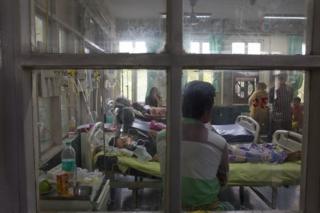Malnutrition is a condition in which a lack of nutrients in the body causes health problems. This is most often the result of a very poor diet that doesn't contain all the vitamins and nutrients needed for the body to function properly. Marasmus is one form of malnutrition.
When a person doesn't get the right nutrients, their bodies __have difficulty going through normal motions like growing or fighting disease. These difficulties can then lead to more serious health problems.
Contents of this article:
- What is marasmus?
- Other forms of severe malnutrition
- Treatment of marasmus
- Prevention of marasmus
What is marasmus?
Marasmus is a severe form of protein-energy malnutrition caused by a shortage of protein and calories in the body. Without these vital nutrients, the body becomes dangerously low in energy and important functions begin to stop.
Both adults and children can be affected by marasmus, but young children in developing countries are affected most often.
It is estimated that 20 million children under the age of five have severe forms of malnutrition like marasmus at some point in their lives, according to UNICEF. About 500,000 to 2 million children die as a result of it.
Marasmus is not always a direct result of a lack of nutrients. It can also be caused by the wrong nutrients, or an inability to absorb or process nutrients properly because of infection.
One study suggests that there are four main causes that lead to marasmus:
- Improper feeding
- Infection, such as syphilis or tuberculosis
- Congenital weakness of disease, such as congenital heart disease
- Very poor sanitary and hygienic conditions that spread disease
Marasmus is also referred to as wasting. It is most often identified by the affected person's physical appearance, which becomes skeletally thin. The loss of body fat and muscle tissue leads to a withered appearance, often described as looking like "skin and bones."
Other symptoms of marasmus include:
- Thin face
- Ribs and shoulders clearly visible through the skin
- Very loose skin that sometimes hangs in folds in the upper arms, thighs, and buttocks
- Persistent dizziness
- Sunken eyes
- Diarrhea
- Active, alert, or irritable behavior
- Frequent dehydration
- Frequent infections that don't show external signs like fever or lesions
Other forms of severe malnutrition
Marasmus is not the only form of severe malnutrition.
Kwashiorkor
Kwashiorkor is another very severe form of protein-energy malnutrition. Very serious cases of marasmus can lead to kwashiorkor. The main difference between the two is that kwashiorkor causes the affected person's body to hold large amounts of fluid in places like the lower legs, feet, arms, hands, and face.
Unlike marasmus, someone affected by kwashiorkor may look like they are of a healthy body weight, or even plump. They may not lose weight, but this is because the fluid buildup is making up for the loss in body fat and muscle tissue.
![[dermatosis hands]](http://cdn1.medicalnewstoday.com/content/images/articles/313/313185/dermatosis-hands.jpg)
Dermatosis is one of the symptoms of kwashiorkor.
Other symptoms of kwashiorkor include:
- Loss of appetite
- Lack of energy
- Irritability
- Changes in hair color to yellow or orange
- Dermatosis - a condition in which patches of skin turn abnormally light or dark, the skin sheds, skin ulcers develop, and lesions begin to leak or bleed
It's critical that kwashiorkor is diagnosed and treated immediately. It is even more life-threatening than marasmus and can lead to death quickly.
Marasmic-kwashiorkor
Marasmic-kwashiorkor is the third form of protein-energy malnutrition. Those affected by this condition experience a combination of marasmus and kwashiorkor. As such, they will show symptoms of both conditions as well.
For example, someone with marasmic-kwashiorkor may:
- Be extremely thin and show signs of wasting
- have excessive fluid buildup in other parts of their body
- Be severely dehydrated
Like with kwashiorkor, it is extremely important that someone showing marasmic-kwashiorkor receives immediate medical treatment. It is more difficult to recover as time goes on, and they face a high risk of death as the condition worsens.
Treatment of marasmus
Marasmus is life-threatening medical emergency, so it's very important to treat it at the onset of symptoms. Other forms of malnutrition may look different but are just as dangerous if left untreated.
Although severe malnutrition is uncommon among children in developed countries, it's important to look out for symptoms that may signal malnourishment. Rapid weight loss, infections, and sudden changes in behavior or appetite could be signs of a bigger problem.
It's a good idea to visit a doctor right away if someone notices any of these symptoms. The longer marasmus goes untreated, the less chance there is of a full recovery.
Research suggests that successfully treating marasmus depends on four factors:
- The patient's age - the younger the patient, the greater chance of death
- How much body weight the patient has lost
- The nutritional treatment given
- The ability of the patient to resist infection
In order to treat marasmus, a treatment plan must be set up by medical professionals if possible.
![[Carb rich Foods]](http://cdn1.medicalnewstoday.com/content/images/articles/313/313185/carb-rich-foods.jpg)
A rich, carbohydrate-filled diet is a good form of treatment, but full recovery can still take months.
There is great difficulty in treating marasmus because the patient needs significantly more calories than a normally nourished person their age. Because their body has lost its fat supply and most of the tissue has been starved, their body no longer has the ability to digest or tolerate a normal amount of food on their own, let alone enough to bring them back to health.
As a result, feeding is usually done in small amounts and through tubes to the veins and stomach. These tubes allow for food and fluid to be delivered quickly and directly to the body.
A diet treatment rich in nutrients, carbohydrates, and calories is very important. It can still take months for a full recovery, even with the right treatment plan.
The complications linked with marasmus such as infections and dehydration must also be treated and prevented to help the patient regain their health.
Prevention of marasmus
The best way to prevent marasmus is to have a well-balanced diet. Foods rich in protein like skimmed milk, fish, eggs, and nuts are important for energy and growth. Vegetables and fruits are important for providing other nutrients and minerals and for preventing malnutrition in general.
Ensuring that complications like dehydration and diarrhea don't reoccur for those who have been malnourished before or affected by marasmus are very important.
Good sanitation and hygiene also play a big role in spreading disease for people in developing countries. Poor sanitation and hygiene can lead to infections that may take a toll on someone who is already close to malnutrition.
Cooking foods at high heat to destroy bacteria can help, as can freezing food and reheating it before eating. Boiling water before drinking, cooking, or bathing in areas where clean water is difficult to access is important to prevent spreading waterborne diseases.
New mothers can also help prevent malnourishment in their newborns by breastfeeding as much as possible.
![[hands holding rice]](http://cdn1.medicalnewstoday.com/content/images/articles/313/313185/hands-holding-rice.jpg)
![[Sad woman]](http://cdn1.medicalnewstoday.com/content/images/articles/313/313098/depressed-woman.jpg)
![[Drunk woman]](http://cdn1.medicalnewstoday.com/content/images/articles/313/313098/drunk-woman.jpg)
![[Woman talking to therapist]](http://cdn1.medicalnewstoday.com/content/images/articles/313/313098/woman-and-therapist.jpg)
![[Woman in Sauna]](http://cdn1.medicalnewstoday.com/content/images/articles/313/313109/woman-in-sauna.jpg)
![[woman in steamy sauna]](http://cdn1.medicalnewstoday.com/content/images/articles/313/313109/steamy-sauna.jpg)
![[Water Glass]](http://cdn1.medicalnewstoday.com/content/images/articles/313/313109/glass-of-water.jpg)
![[cancerous cells graphic image]](http://cdn1.medicalnewstoday.com/content/images/articles/313/313159/cancerous-cells.jpg)
![[DNA graphic]](http://cdn1.medicalnewstoday.com/content/images/articles/313/313159/dna.jpg)
![[Cancer patient consulting doctor]](http://cdn1.medicalnewstoday.com/content/images/articles/313/313159/cancer-cobsulatation.jpg)













